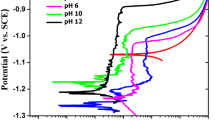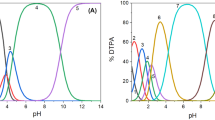Abstract
In this study, the electrodeposition technique has been used to deposit low concentrations of highly toxic lead (Pb) cations into a solution of nitrate at a constant potential of − 1 V on fluorine-doped tin oxide electrodes (FTO). Monitoring of the reaction was conducted with the assistance of a computerized potentiostat/galvanostat setup, in cyclic voltammetry and in situ chronoamperometry modemodes. X-ray diffraction, scanning electron microscopy, energy-dispersive X-Ray, and ultraviolet–visible spectroscopy techniques were used to examine the crystal structure, morphology, and optical properties of the lead deposits, respectively. Pb regular micro-hexagons have been identified; their size and density were significantly influenced by the cationic precursor’s concentration. The correlation between the morphological and crystallographical structures of the electrodeposits was discussed. Based on chronoamperometric measurements, a mechanism for the growth of Pb deposits on FTO substrate has been proposed. Based on the reported results, electrodeposition processes of low heavy metals concentrations in contaminated water could be optimized using the eco-friendly electrodeposition technique.









Similar content being viewed by others
Data availability
This manuscript has associated data in a data repository. [Authors’ comment: All data generated or analysed during this study are included in this published article [and its supplementary information files.]]
References
T. Thompson, J. Fawell, S. Kunikane, D. Jackson, S. Appleyard, P. Callan, J. Bartram, P. Kingston, S. Water, World Health Organization, Chemical safety of drinking water: assessing priorities for risk management (World Health Organization, Geneva, 2007)
L. Wang, Dual-functional lead (II) metal-organic framework based on 5-Aminonicotinic acid as a luminescent sensor for selective sensing of nitroaromatic compounds and detecting the temperature. J. Inorg. Organomet. Polym. Mater. 30, 291–298 (2019)
National Research Council and Safe Drinking Water Committee, An Evaluation of Activated Carbon for Drinking Water Treatment, Drinking water and health: volume 2, (National Academies Press (US), 1980). https://doi.org/10.17226/1904
E.A. Abdelrahman, R.M. Hegazey, A. Alharbi, Facile synthesis of mordenite nanoparticles for efficient removal of Pb(II) ions from aqueous media. J. Inorg. Organomet. Polym. Mater. 30, 1369–1383 (2019)
N.T. Moja, S.B. Mishra, S.S. Hwang, T.Y. Tsai, A.K. Mishra, Coordination of Lead (II) and Cadmium (II) Ions to Nylon 6/Flax Linum composite as a route of removal of heavy metals. J. Inorg. Organomet. Polym. Mater. (2021). https://doi.org/10.1007/S10904-021-02052-8
M. Szklarczyk, J.O.M. Bockris, In situ STM studies of lead electrodeposition on graphite substrate. J. Electrochem. Soc. 137, 452–457 (1990)
W. Zerguine, D. Abdi, F. Habelhames, M. Lakhdari, H. Derbal-Habak, Y. Bonnassieux, D. Tondelier, J. Choi, J.M. Nunzi, Annealing effect on the optical and photoelectrochemical properties of lead oxide. Eur. Phys. J. Appl. Phys. 84, 30301 (2018)
T. Ishiyama, K.-I. Abe, T. Tanaka, A. Mizuike, Determination of trace lead in copper by cathodic stripping voltammetry. Anal. Sci. 12, 263–265 (1996)
S. Prakash, V.K. Shahi, Improved sensitive detection of Pb 2+ and Cd 2+ in water samples at electrodeposited silver nanonuts on a glassy carbon electrode. Anal. Methods 3, 2134–2139 (2011)
N. Nikolić, P.M. Zivkovic, S. Stevanović, G. Brankovic, Relationship between the kinetic parameters and morphology of electrochemically deposited lead. J. Serb. Chem. Soc. 81, 553–566 (2016)
L. Meng, J. Ustarroz, M.E. Newton, J.V. Macpherson, Elucidating the cathodic electrodeposition mechanism of lead/lead oxide formation in nitrate solutions. J. Phys. Chem. C 121(12), 6835–6843 (2017)
C.-J. Yang, Xu. Lv-xing Zhao, D.-C. Zhang, Gu. Yu, Insight into oxidation of lead powder during electrodeposition. Prot. Met. Phys. Chem. Surf. 56(2), 302–310 (2020)
V.I. Pryakhina, E.V. Gunina, B.I. Lisjikh, M.A. Osipova, E.D. Greshnyakov, E.V. Shishkina, V. Ya Shur, in Shapes Change of PbO Nanoparticles Produced by Laser Ablation in Liquid. IOP Conference Series: Materials Science and Engineering vol: 699, no. 1 (2019) pp. 012038
Smart, Clarence F. Electrodeposition of lead and lead alloys. United States US2751341A, filed 22 September 1952, and issued 19 June 1956. https://patents.google.com/patent/US2751341A/en.
N.A. Pangarov, The crystal orientation of electrodeposited metals. Electrochim. Acta 7(1), 139–146 (1962)
M.A.M. Ibrahim, M.A. Amin, M.A. Abbass, Electrodeposition of lead from acetate electrolyte containing additives. Trans. IMF 82, 87–92 (2004). https://doi.org/10.1080/00202967.2004.11871567
M. Girgis, E. Ghali, Effect of temperature on cyclic voltammograms during the electrodeposition of lead. Can. J. Chem. 67(1), 130–136 (1989)
V. Protsenko, E. Eva, F. Danilov, Electrodeposition of lead coatings from a methanesulphonate electrolyte. J. Chem. Technol. Metall. 50, 39–43 (2015)
M. Khelladi, L. Mentar, M. Boubatra, A. Azizi, A. Kahoul, Early stages of cobalt electrodeposition on FTO and n-type Si substrates in sulfate medium. Mater. Chem. Phys. 122, 449–453 (2010)
Z. Banyamin, P. Kelly, G. West, J. Boardman, Electrical and optical properties of fluorine doped tin oxide thin films prepared by magnetron sputtering. Coatings 4, 732–746 (2014)
A. Ray, Electrodeposition of thin films for low-cost solar cells, electroplating of nanostructures. IntechOpen (2015). https://doi.org/10.5772/61456
J. González-García, J. Iniesta, A. Aldaz, V. Montiel, Effects of ultrasound on the electrodeposition of lead dioxide on glassy carbon electrodes. New J. Chem. 22, 343–349 (1998)
J. González-García, J. Iniesta, E. Expósito, V. García-García, V. Montiel, A. Aldaz, Early stages of lead dioxide electrodeposition on rough titanium. Thin Solid Films 352, 49–56 (1999)
J. González-García, F. Gallud, J. Iniesta, V. Montiel, A. Aldaz, A. Lasia, Kinetics of electrocrystallisation of PbO2 on glassy carbon electrodes: influence of ultrasound. New J. Chem. 25, 1195–1198 (2001)
J. González-García, F. Gallud, J. Iniesta, M. Montiel, A. Aldaz, A. Lasia, Kinetics of electrocrystallization of PbO2 on glassy carbon electrodes. Influence of the electrode rotation. Electroanalysis 13, 1258–1264 (2001)
I. Shtepliuk, M. Vagin, I.G. Ivanov, T. Iakimov, G.R. Yazdi, R. Yakimova, Lead (Pb) interfacing with epitaxial graphene. Phys. Chem. Chem. Phys. 20, 17105–17116 (2018)
V. Sáez, J. González-Garcı́a, J. Iniesta, A. Frı́as-Ferrer, A. Aldaz, Electrodeposition of PbO2 on glassy carbon electrodes: influence of ultrasound frequency. Electrochem. Commun. 6, 757–761 (2004)
I. Massoudi, A. Rebey, Analysis of in situ thin films epitaxy by reflectance spectroscopy: effect of growth parameters. Superlattices Microstruct. 131, 66–85 (2019)
O. Oda, Compound semiconductor bulk materials and characterizations. (World Scientific, 2007). https://doi.org/10.1142/2323
W.S. Werner, K. Glantschnig, C. Ambrosch-Draxl, Optical constants and inelastic electron-scattering data for 17 elemental metals. J. Phys. Chem. Ref. Data 38, 1013–1092 (2009)
H. Yang, R.G. Reddy, Fundamental studies on electrochemical deposition of lead from lead oxide in 2: 1 urea/choline chloride ionic liquid. J. Electrochem. Soc. 161, D586 (2014)
N. Sugumaran, P. Everill, S.W. Swogger, D.P. Dubey, Lead acid battery performance and cycle life increased through addition of discrete carbon nanotubes to both electrodes. J. Power Sources 279, 281–293 (2015)
N.D. Nikolić, V.M. Maksimović, G. Branković, Morphological and crystallographic characteristics of electrodeposited lead from a concentrated electrolyte. RSC Adv. 3, 7466–7471 (2013)
C.-Z. Yao, M. Liu, P. Zhang, X.-H. He, G.-R. Li, W.-X. Zhao, P. Liu, Y.-X. Tong, Tuning the architectures of lead deposits on metal substrates by electrodeposition. Electrochim. Acta 54, 247–253 (2008)
J. Matthews, Accommodation of misfit across the interface between single-crystal films of various face-centred cubic metals. Philos. Mag. 13, 1207–1221 (1966)
G. Arrhenius, X-ray diffraction procedures for polycrystalline and amorphous materials. vol: 228 (ACS Publications, 1955)
S.S. Djokić, Electrodeposition and surface finishing (Springer, New York, 2014)
K.I. Popov, E.R. Stojilković, V. Radmilović, M.G. Pavlović, Morphology of lead dendrites electrodeposited by square-wave pulsating overpotential. Powder Technol. 93, 55–61 (1997)
N.D. Nikolić, K.I. Popov, E.R. Ivanović, G. Branković, S.I. Stevanović, P.M. Živković, Thepotentiostatic current transients and the role of local diffusion fields in formation of the 2D lead dendrites from the concentrated electrolyte. J. Electroanal. Chem. 739, 137–148 (2015)
S. Cherevko, X. Xing, C.H. Chung, Hydrogen template assisted electrodeposition of sub-micrometer wires composing honeycomb-like porous Pb films. Appl. Surf. Sci. 257, 8054–8061 (2011)
N.D. Nikolic, K.I. Popov, P.M. Zivkovic, G. Brankovic, A new insight into the mechanism of lead electrodeposition: ohmic-diffusion control of the electrodeposition process. J. Electroanal. Chem. 691, 66–76 (2013)
A. Rajamani, U.B.R. Ragula, N. Kothurkar, M. Rangarajan, Nano-and micro-hexagons of bismuth on polycrystalline copper: electrodeposition and heavy metal sensing. Cryst Eng Comm. 16, 2032–2038 (2014)
S. Gupta, R. Singh, M. Anoop, V. Kulshrestha, D.N. Srivastava, K. Ray, S. Kothari, K. Awasthi, M. Kumar, Electrochemical sensor for detection of mercury (II) ions in water using nanostructured bismuth hexagons. Appl. Phys. A 124, 737 (2018)
A. Zimmer, L. Broch, C. Boulanger, N. Stein, Morphological and chemical dynamics upon electrochemical cyclic sodiation of electrochromic tungsten oxide coatings extracted by in situ ellipsometry. Electrochim. Acta 174, 376–383 (2015)
M. Paunovic, M. Schlesinger, Fundamentals of electrochemical deposition (John Wiley & Sons Inc, Hoboken, 2005)
Y. Katayama, R. Fukui, T. Miura, Electrodeposition of lead from 1-butyl-1-methylpyrrolidinium Bis(trifluoromethylsulfonyl) amide ionic liquid. J. Electrochem. Soc. 160, D251–D255 (2013)
A. Liu, Z. Shi, R.G. Reddy, Electrodeposition of Pb from PbO in urea and 1-butyl-3-methylimidazolium chloride deep eutectic solutions. Electrochim. Acta 251, 176–186 (2017)
Acknowledgements
The authors gratefully acknowledge Qassim University, represented by Deanship of scientific “Research, on the financial support for this research under the number (10130-cos-2020-1-3-I) during the academic year 1442AH/2020AD”
Author information
Authors and Affiliations
Corresponding author
Additional information
Ahmed Rebey is the scientific name, but the official name is Hamad AlHadi Rebei. The author is known by the name A. Rebey in Scopus, Google Scholar and ResarchGate.
Rights and permissions
About this article
Cite this article
Rebey, A., Hamdi, R. & Hammami, B. Analysis of growth mechanisms and microstructure evolution of Pb+2 minor concentrations by electrodeposition technique. Eur. Phys. J. Plus 137, 295 (2022). https://doi.org/10.1140/epjp/s13360-022-02345-y
Received:
Accepted:
Published:
DOI: https://doi.org/10.1140/epjp/s13360-022-02345-y




